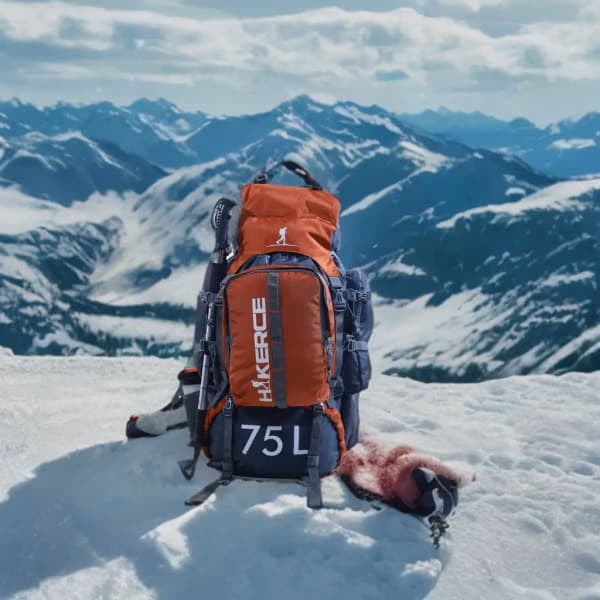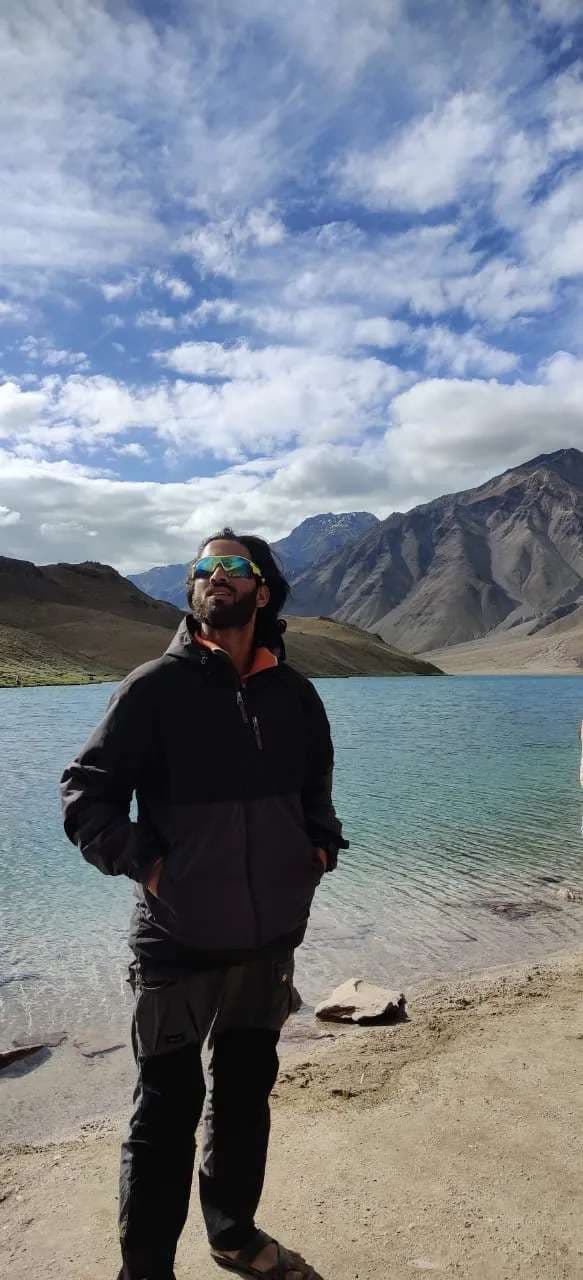Mount Trishul comes in the high mountain ranges of India, it is a group of three mountains, it is seen in the shape of Trishul, that is, in English W shape. According to Hindu mythology, it has been associated with the trident of Lord Shiva. This mountain range forms a 9mile circle in the southwest corner of the Nanda Devi Sanctuary under the Kumaon region of Uttarakhand. It can be clearly seen from many famous peaks of Uttarakhand like Roopkund, Brahmantal, Kedarkantha etc. The height of these mountains is Trishul 1 (7120m), Trishul 2 (6690m) Trishul 3 (6007). It is considered as a moderate to difficult mountain peak. As per the records, Trishul-1 was the first peak over 7000 m ever been attempted way back in 1907 by T. G. Longstaff.
At Mount Trishul Expedition, we are passionate about sharing the thrill of high-altitude adventures with adventurers and explorers from around the world. Standing proudly at 7,120 meters (23,360 feet) above sea level, Mount Trishul is a formidable peak in the Indian Himalayas. Its distinctive three-pronged summit is a sight to behold, challenging mountaineers and alpinists with its steep faces and unpredictable weather conditions. Our expeditions to Mount Trishul are nestled in the Garhwal region of the state of Uttarakhand, India. This breathtaking location provides a serene backdrop of lush forests, alpine meadows, and pristine lakes. It's not just a mountain; it's an immersion in the natural beauty of the Himalayan wilderness.
The weather on Mount Trishul is as dynamic as the mountain itself. Summers offer relatively milder temperatures, making it the ideal time for climbers. However, even in the warmer months, unpredictable weather patterns can pose challenges. Winters, on the other hand, bring frigid temperatures and heavy snowfall, transforming the region into a challenging winter mountaineering destination. At Mount Trishul Expedition, our experienced guides, state-of-the-art equipment, and unwavering commitment to safety ensure that your journey to the summit is not just an adventure but a life-changing experience.
Best Time To Do Mount Trishul
The best time to undertake a Mount Trishul expedition is generally during the pre-monsoon season from May to June and the post-monsoon season from September to October. Here's a breakdown of why these periods are preferred:
May to June (Pre-Monsoon):
Weather: During this period, the weather is relatively stable with milder temperatures. Days are longer, and the snow starts to melt, making the climbing conditions more favorable.
Snow Conditions: There is still snow on the mountain, which can offer excellent climbing conditions. However, the snow is not as deep as in the peak of winter.
Visibility: The skies are generally clearer, providing better visibility for climbers to enjoy the breathtaking vistas of the Himalayas.
September to October (Post-Monsoon):
Weather: After the monsoon season, the weather begins to stabilize in September. The skies clear up, and the temperatures are generally pleasant.
Snow Conditions: While the snow might be less than in the pre-monsoon season, it can still provide good climbing conditions. The mountain is less prone to avalanches and rockfalls.
Post-Monsoon Beauty: This period allows climbers to witness the lush, green landscapes of the Himalayan foothills, adding a different dimension to the overall expedition experience.
It's important to note that while these are generally the preferred time frames for Mount Trishul expeditions, the weather in the Himalayas can be unpredictable, and conditions can change rapidly.
Difficulty Level Of Mount Trishul Expedition
The Mount Trishul expedition is considered a challenging and technically demanding mountaineering endeavor. Several factors contribute to the difficulty of this expedition:
High Altitude: Mount Trishul stands at an elevation of 7,120 meters (23,360 feet) above sea level. Climbers will face the challenges associated with high-altitude mountaineering, such as reduced oxygen levels, altitude sickness, and physical exhaustion.
Technical Difficulty: Mount Trishul is known for its steep and technically challenging climbing routes. The mountain features various rock and ice faces, requiring climbers to have advanced mountaineering skills, including ice and rock climbing techniques.
Weather Conditions: The weather on Mount Trishul can be extremely unpredictable and harsh. Climbers may encounter heavy snowfall, high winds, and sub-zero temperatures, especially during the winter months, which can increase the difficulty and danger of the expedition.
Avalanche and Rockfall Risk: The mountain's terrain is prone to avalanches and rockfalls, posing significant hazards to climbers. Careful route planning and avalanche awareness are essential for safety.
Remote Location: Mount Trishul is located in a remote region of the Indian Himalayas, far from major towns and cities. This remoteness means that climbers must be self-sufficient and prepared for extended periods in a wilderness environment.
Physical and Mental Endurance: Successful ascents of Mount Trishul require a high level of physical fitness, endurance, and mental resilience. Climbers must be prepared to endure challenging conditions and maintain focus and determination throughout the expedition.
Due to these factors, climbing Mount Trishul is typically recommended for experienced mountaineers with prior high-altitude and technical climbing experience. It is crucial for climbers to undergo thorough training, acclimatization, and preparation before attempting this challenging ascent.
Things To Carry For The Mount Trishul Expedition
Climbing Mount Trishul in the Indian Himalayas is a challenging and high-altitude endeavor that requires careful preparation and appropriate gear. Here's a list of essential items and equipment you should carry for an Expedition:
1. Clothing:
Base Layers: Moisture-wicking thermal tops and bottoms to manage sweat and maintain body warmth.
Insulating Layers: Down or synthetic insulated jacket and pants for added warmth at higher altitudes.
Hardshell Jacket and Pants: Waterproof and windproof outer layers to protect against rain, snow, and wind.
Climbing Suit: A one-piece climbing suit designed for high-altitude expeditions.
Headwear: Warm hat, balaclava, and sun hat for protection from the elements.
Gloves: Insulated and waterproof gloves for hand protection.
2. Footwear:
Mountaineering Boots: Insulated, high-altitude mountaineering boots suitable for extreme cold and technical climbing.
Gaiters: Waterproof gaiters to keep snow and debris out of your boots.
Socks: Moisture-wicking and warm socks designed for high-altitude climbing.
3. Climbing Gear:
Harness: A climbing harness for safety during technical sections.
Helmet: A climbing helmet to protect against falling objects.
Crampons: Technical crampons designed for high-altitude use.
Ice Axe: A technical ice axe for snow and ice climbing.
Ascender and Descender: For rope work and rappelling.
Carabiners, Slings, and Prusiks: Essential climbing hardware.
Ropes: Appropriate climbing ropes for the expedition.
Climbing Protection: Depending on the route, bring protection devices like ice screws and snow pickets.
Avalanche Safety Gear: If applicable, carry avalanche transceivers, probes, and shovels.
4. Camping Gear:
Tent: A sturdy, high-altitude tent suitable for extreme conditions.
Sleeping Bag: A high-quality, cold-rated sleeping bag.
Sleeping Pad: Insulated sleeping pad for warmth and comfort.
Cooking Equipment: Lightweight stoves, cookware, and utensils for preparing meals at high altitudes.
Food and Hydration: High-energy, high-calorie foods, and a water filtration system or purification tablets.
Backpack: A mountaineering backpack to carry your gear during the climb.
5. Navigation and Safety:
Maps and Compass: Detailed topographic maps of the area and a reliable compass.
GPS Device: For accurate navigation and tracking.
Headlamp: With extra batteries for nighttime climbing.
First Aid Kit: A comprehensive kit with essentials for high-altitude injuries and ailments.
Communication: Satellite phone or two-way radios for emergency communication.
6. Personal Items:
Sunglasses: High-quality glacier sunglasses with UV protection.
Sunscreen: High SPF sunscreen to protect against strong mountain sun.
Lip Balm: To prevent chapped lips in dry, high-altitude conditions.
Toiletries: Basic hygiene items like toothbrush, toothpaste, and biodegradable soap.
Personal Medications: Any prescribed medications or personal medical supplies.
7. Miscellaneous:
Repair Kit: Tools and materials for equipment repairs.
Duct Tape: Useful for quick fixes in the field.
Trash Bags: To pack out all waste and leave no trace.
Cash: For emergencies and incidentals.
How To Prepare For Mount Trishul Expedition
Preparing for an expedition to Mount Trishul, one of the challenging peaks in the Indian Himalayas, requires careful planning, physical conditioning, and the acquisition of necessary skills and equipment. Here's a comprehensive guide on how to prepare for a successful Mount Trishul Expedition:
1. Physical Fitness:
Start a comprehensive fitness regimen well in advance of your expedition. Focus on cardiovascular endurance, strength training, flexibility, and stamina.
Incorporate aerobic exercises like running, cycling, and hiking to improve your cardiovascular fitness.
Include strength training exercises to build core strength and muscular endurance.
Regularly engage in uphill trekking and hiking to simulate the conditions of high-altitude climbs.
2. Altitude Acclimatization:
Allow adequate time for altitude acclimatization during the trek to the base camp and higher camps. Rushing the ascent can lead to altitude-related illnesses.
Monitor team members for symptoms of altitude sickness, such as headaches, nausea, and dizziness, and respond promptly with appropriate actions.
3. Technical Skills:
High-altitude climbing requires technical skills in ice and rock climbing, crevasse rescue, rope work, and navigation.
Consider enrolling in mountaineering courses or training programs to acquire these skills if you are not already proficient.
Practice using crampons, ice axes, ropes, and other climbing equipment.
4. Mental Preparation:
Develop a strong mental attitude and resilience. High-altitude climbs can be physically and mentally challenging.
Familiarize yourself with the potential risks and challenges of high-altitude climbing and how to mitigate them.
Practice mental techniques like meditation and visualization to stay calm under pressure.
5. Gear and Equipment:
Invest in high-quality climbing gear and clothing suited for high-altitude conditions. This includes insulated mountaineering boots, down clothing, harness, helmet, and technical climbing equipment.
Ensure all gear is well-fitted and in excellent condition.
Learn how to use and maintain your equipment.
6. Health and Nutrition:
Prioritize your health by getting regular check-ups and vaccinations. Consult a healthcare professional to assess your fitness for high-altitude climbs.
Plan a balanced diet rich in carbohydrates, proteins, and healthy fats to maintain energy levels.
Stay hydrated at all times and avoid alcohol and tobacco, which can impair acclimatization.
7. Permits and Logistics:
Obtain all necessary permits and permissions for the expedition well in advance. Ensure you are aware of any local regulations and restrictions.
Make logistical arrangements for transportation, accommodations, and support staff, if applicable.
8. Emergency Preparedness:
Develop an emergency plan that includes communication devices, first aid supplies, and evacuation procedures.
Learn basic wilderness first aid and rescue techniques.
9. Team and Leadership:
Assemble a competent and experienced team, including guides and support staff, who are familiar with the region and the climb.
Establish effective communication and teamwork among team members.
10. Leave No Trace Principles:
Follow Leave No Trace principles to minimize your environmental impact during the expedition. Dispose of waste properly and avoid contaminating water sources.
11. Stay Informed:
Stay updated on weather forecasts and current conditions in the region. Be prepared to adjust your plans if necessary.
Remember that safety should always be the top priority. Proper preparation, training, and safety measures are essential for a successful and safe Mount Trishul Expedition. Consult with experienced climbers and guides, and consider joining an organized expedition led by professionals if you are new to high-altitude climbing.
Safety Factors Of Mount Trishul Expedition
Safety is paramount on a Mount Trishul expedition due to the challenging nature of the climb and the unpredictable Himalayan environment. Several safety factors must be considered:
Proper Acclimatization: Adequate acclimatization is crucial to prevent altitude sickness. The expedition should include gradual ascents with sufficient rest days to allow climbers to acclimatize to the high altitude.
Weather Monitoring: Continuous monitoring of weather conditions is vital. Sudden weather changes, storms, and avalanches are common in the Himalayas. Expedition leaders should have access to up-to-date weather forecasts and be prepared to adjust plans accordingly.
Emergency Evacuation Plan: A well-defined emergency evacuation plan should be in place, including communication systems for distress calls, access to helicopters for medical evacuations, and a designated medical kit for treating altitude-related illnesses and injuries.
Avalanche Awareness: Due to the steep terrain and snow-covered slopes, climbers must be trained in avalanche awareness and carry the necessary safety equipment, such as avalanche beacons, shovels, and probes.
Technical Skills: Climbers should possess advanced technical skills in ice and rock climbing, as well as crevasse rescue techniques. This ensures they can navigate challenging terrain and respond to emergencies effectively.
Equipment Inspection: Regular inspection and maintenance of climbing gear are essential to prevent equipment failure during the ascent. This includes ropes, harnesses, ice axes, crampons, and helmets.
Communication: Reliable communication systems, such as satellite phones or radios, are essential for staying in contact with base camp and obtaining assistance in case of emergencies.
Proper Clothing: Cold weather gear, including high-quality down jackets, insulated pants, and extreme cold-weather boots, is vital to protect against freezing temperatures and frostbite.
Physical and Mental Preparedness: Climbers should be in excellent physical shape and mentally prepared for the physical and psychological challenges of the expedition. Recognizing personal limits and communicating concerns is crucial for safety.






















